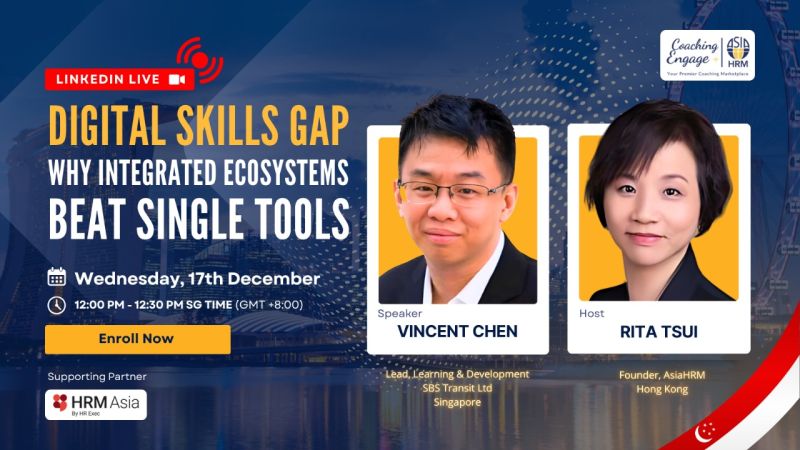Navigating the workforce and skills transformation in the age of AI
- HRM Asia Newsroom

The genie has escaped the bottle and AI is everywhere now, and HR leaders must understand its implications and steer organisations toward a future in which humans and machines can coexist. While integrating these technologies offers a promising outlook to augment human capabilities and drive innovation, it is equally true that this journey is full of challenges and unknowns. Think of it as navigating through a thick fog—there is a lot we cannot see yet, and we are learning as we go. The path is unclear, demanding HR leaders to learn, adapt, and lead with resilience.
The challenge ahead
Integrating AI into our workplaces is not just about new gadgets or software. It is about redesigning work—think about the ways of working and growing skills. And with any significant change, there is a bit of unease. According to a survey by the World Economic Forum, by 2025, automation and AI are expected to create 97 million new jobs but also displace 85 million jobs. This means we have a massive task to prepare our workforce for new roles and opportunities. HR leaders themselves must embark on a continuous learning journey. The evolution of technology is rapid and unpredictable, requiring HR leaders to remain agile, informed, and ready to pivot as new trends emerge and old ones fade. This adaptability is crucial in staying ahead of the curve and leading our organisations through the required cultural and structural changes.
Guiding change with empathy
Bringing AI into the workplace is like remodelling an old house while you are still living in it. It is messy, disruptive, and requires patience and adaptability. This is where our skills in change management come into play. We must help employees in the organisation understand why we are making changes, the benefits, and how they can be part of this new future. It is not just about sending a memo or hosting a training session. It is about ongoing conversations, listening to concerns, and providing support every step of the way.
 “Implementing AI and technology is more about managing human emotions than technical deployment.” – Anish Lalchandani, Author and Global HR Leader
“Implementing AI and technology is more about managing human emotions than technical deployment.” – Anish Lalchandani, Author and Global HR Leader
Implementing AI and technology is more about managing human emotions than technical deployment. Effective change management is critical in mitigating fears of layoffs and fostering an environment where employees are excited about the possibilities of AI augmentation. It is a cultural transformation, and HR must lead by crafting narratives highlighting technology’s positive impacts on individual roles, the value of upskilling and reskilling, and the opportunities for career development in the new world of work. This requires transparent communication, participatory decision-making processes, and a supportive framework to ease the transition and foster a culture of innovation and adaptability.
The dual role of HR: Learning and leading
As HR navigates these waters, the dual role of learning and leading becomes critical. HR leaders must lead by example, by focusing on continuous learning and staying abreast of the trends on workforce dynamics, future skills, and effective change management practices. This involves a commitment to personal and professional development and creating networks and communities of practice that enable the sharing of insights and strategies. For HR leaders to succeed in the future of work, they must look beyond information and trends and proactively address any issues. Specifically, it is about how these trends impact business and, therefore, jobs and skills and what we can do to integrate humans and machines. They must be deliberate about their choices in managing the changes; they should be committed to addressing business issues and not just go after the new and shiny HR thing.
READ MORE: Five ways organisations can use AI to supercharge interview scheduling
Conclusion: A journey of transformation
Integrating AI into the workforce, enhancing human capabilities, and fostering a future-ready organisation is complex and challenging. It requires HR leaders to be learners as much as leaders, manage change with empathy and precision, and navigate technological evolution uncertainties with strategic foresight. By acknowledging the difficulties, embracing the need for continuous adaptation, and deploying comprehensive change management strategies to address business needs, HR leaders can guide their organisations through this by keeping our people at the centre of everything we do and turn the challenges of tomorrow into the opportunities of today.
About the author: Anish Lalchandani is a Global HR Leader and author of the book ‘The Skills Advantage: A Human-Centred, Sustainable and Scalable Approach to Reskilling’. Join him at HR Tech Festival Asia 2024 on April 24 at the Talent Unleashed content theatre at 3.15pm (SGT), where Anish will provide key insights into how organisations can redefine the talent experience by investing in human capital.






